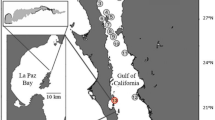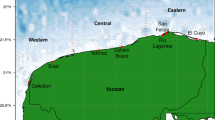Abstract
Steller sea lions (Eumetopias jubatus) were fed restricted iso-caloric amounts of Pacific herring (Clupea pallasi) or walleye pollock (Theragra chalcogramma) for 8–9 days, four times over the course of a year to investigate effects of season and prey composition on sea lion physiology. At these levels, the sea lions lost body mass at a significantly higher rate during winter (1.6 ± 0.14 kg day−1), and at a lower rate during summer (1.2 ± 0.32 kg day−1). Decreases in body fat mass and standard metabolic rates during the trials were similar throughout the seasons and for both diet types. The majority of the body mass that was lost when eating pollock derived from decreases in lipid mass, while a greater proportion of the mass lost when eating herring derived from decreases in lean tissue, except in the summer when the pattern was reversed. Metabolic depression was not observed during all trials despite the constant loss of body mass. Our study supports the hypothesis that restricted energy intake may be more critical to Steller sea lions in the winter months, and that the type of prey consumed (e.g., herring or pollock) may have seasonally specific effects on body mass and composition.


Similar content being viewed by others

References
Alverson DL (1992) Commercial fisheries and the Steller sea lion (Eumetopias jubatus): the conflict arena. Rev Aquat Sci 6:203–256
Armitage KB, Shulenberger E (1972) Evidence for a circannual metabolic cycle in Citellus tridecemlineatus, a hibernator. Comp Biochem Physiol A 42:667–688
Arnould JPY, Boyd IL, Speakman JR (1996) Measuring the body composition of Antarctic fur seals (Arctocephalus gazella): validation of hydrogen isotope dilution. Physiol Zool 69:93–116
Ashwell-Erickson S, Fay FH, Elsner R, Wartzok D (1986) Metabolic and hormonal correlates of molting and regeneration of pelage in Alaskan harbor and spotted seals (Phoca vitulina and Phoca largha). Can J Zool 64:1086–1094
Bailey ED (1965) Seasonal changes in metabolic activity of non-breeding woodchucks. Can J Zool 43:905–909
Beauplet G, Guinet C, Arnould JPY (2003) Body composition changes, metabolic fuel use, and energy expenditure during extended fasting in subantarctic fur seal (Arctocephalus tropicalis) pups at Amsterdam island. Physiol Biochem Zool 76:262–270
Boily P (1996) Metabolic and hormonal changes during the molt of captive gray seals (Halichoerus grypus). Am J Physiol Regul Integr Comp Physiol 270:R1051–R1058
Boily P, Lavigne DM (1997) Developmental and seasonal changes in resting metabolic rates of captive female grey seals. Can J Zool 75:1781–1789
Bryden MM, Molyneux GS (1978) Arteriovenous anastomoses in the skin of seals. II. The California sea lion Zalophus californianus and the northern fur seal Callorhinus ursinus (Pinnipedia: Otariidae). Anat Rec 191:253–260
Calkins DG, Becker EF, Pitcher KW (1998) Reduced body size of female Steller sea lions from a declining population in the Gulf of Alaska. Mar Mamm Sci 14:232–244
Campbell KL, MacArthur RA (1998) Nutrition and the energetic tactics of muskrats (Ondatra zibethicus): morphological and metabolic adjustments to seasonal shifts in diet quality. Can J Zool 76:163–174
Cherel Y, Heitz A, Calgari C, Robin J-P, Le Maho Y (1992) Relationships between lipid availability and protein utilization during prolonged fasting. J Comp Physiol B 162:305–313
Daniel RG (2003) The timing of moulting in wild and captive Steller sea lions (Eumetopias jubatus). M.Sc. thesis, Department of Zoology. University of British Columbia, Vancouver, 64 pp
Donohue MJ, Costa DP, Goebel ME, Baker JD (2000) The ontogeny of metabolic rate and thermoregulatory capabilities of Northern fur seal, Callorhinus ursinus, pups in air and water. J Exp Biol 203:1003–1016
Geraci JR (1975) Pinniped nutrition. Rapports et Proces-verbaux des Reunion Conseil International pour l’Exploration de la Mer 169:312–323
Guinet C, Roux JP, Bonnet M, Mison V (1998) Effect of body size, body mass, and body condition on reproduction of female South African fur seals (Arctocephalus pusillus) in Namibia. Can J Zool 76:1418–1424
Hedd A, Gales R, Renouf D (1997) Inter-annual consistency in the fluctuating energy requirements of captive harp seals Phoca groenlandica. Polar Biol 18:311–318
Holand Ø (1992) Seasonal variation in body composition of European roe deer. Can J Zool 70:502–504
Holmes EE, York AE (2003) Using age structure to detect impacts on threatened populations: a case study with Steller sea lions. Conserv Biol 17:1794–1806
Kastelein RA, Vaughan N, Wiepkema PR (1990) The food consumption of Steller sea lions (Eumetopias jubatus). Aquat Mamm 15:137–144
Kleiber M (1975) The fire of life: an introduction to animal energetics. Robert E. Krieger Publishing, New York
Korhonen H (1988) Seasonal comparison of body composition and hair coat structure between mink and polecat. Comp Biochem Physiol A 3:469–473
Lager AR, Nordøy ES, Blix AS (1994) Seasonal changes in food intake of harp seals (Phoca groenlandica) at 69°N. Mar Mamm Sci 10:332–341
Lehmer EM, Van Horne B (2001) Seasonal changes in lipids, diet, and body composition of free-ranging black-tailed prairie dogs (Cynomys ludovicianus). Can J Zool 79:955–965
Luque SP, Aurioles-Gamboa D (2001) Sex differences in body size and body condition of California sea lion (Zalophus californianus) pups from the Gulf of California. Mar Mamm Sci 17:147–160
Markussen NH, Ryg M, Øritsland NA (1992) Metabolic rate and body composition of harbour seals, Phoca vitulina, during starvation and refeeding. Can J Zool 70:220–224
Merrick RL, Loughlin TR (1997) Foraging behavior of adult female and young-of-year Steller sea lions in Alaskan waters. Can J Zool 75:776–786
Merrick RL, Chumbley MK, Byrd GV (1997) Diet diversity of Steller sea lions (Eumetopias jubatus) and their population decline in Alaska: a potential relationship. Can J Fish Aquat Sci 54:1342–1348
Nilssen KJ, Sundersfjord JA, Blix AS (1984) Regulation of metabolic rate in Svalbard and Norwegian reindeer. Am J Physiol 247:R837–R841
Nitto H, Kawamura T, Baba N (1998) Changes in body weight of the Steller sea lion (Eumetopias jubatus) in captivity. J Jpn Assoc Zool Gardens Aquar 40:8–13
Noren DP, Mangel M (2004) Energy reserve allocation in fasting northern elephant seal pups: inter-relationships between body condition and fasting duration. Funct Ecol 18:233–242
Øritsland NA (1990) Starvation survival and body composition in mammals with particular reference to Homo sapiens. Bull Math Biol 52:643–655
Pitcher KW, Calkins DG (1981) Reproductive biology of Steller sea lions in the Gulf of Alaska. J Mammal 62:599–605
Pitcher KW, Calkins DG, Pendleton G (1998) Reproductive performance of female Steller sea lions: an energetics-based reproductive strategy? Can J Zool 76:2075–2083
Pitcher KW, Calkins DG, Pendleton GW (2000) Steller sea lion condition indices. Mar Mamm Sci 16:427–436
Pulawa LK, Florant GL (2000) The effects of caloric restriction on the body composition and hibernation of the golden-mantled ground squirrel (Spermophilus lateralis). Physiol Biochem Zool 73:538–546
Rea LD, Rosen DAS, Trites AW (1999) Seasonal differences in adaptation to prolonged fasting in juvenile Steller sea lions (Eumetopias jubatus). FASEB J 13(5):A740
Reidy SP, Webber J-M (2000) Leptin: an essential regulator of lipid metabolism. Comp Biochem Physiol A 125:285–297
Reilly JJ, Fedak MA (1990) Measurement of the body composition of living gray seals by hydrogen isotope dilution. J Appl Physiol 69:885–891
Renouf D, Gales R, Noseworthy E (1993) Seasonal variation in energy intake and condition of harp seals: is there a harp seal morph? Problems for bioenergetic modelling. J Zool (Lond) 230:513–528
Rosen DAS, Renouf D (1998) Correlates to seasonal changes in metabolism in Atlantic harbour seals (Phoca vitulina concolor). Can J Zool 76:1520–1528
Rosen DAS, Trites AW (1999) Metabolic effects of low-energy diet on Steller sea lions, Eumetopias jubatus. Physiol Biochem Zool 72:723–731
Rosen DAS, Trites AW (2000a) Digestive efficiency and dry-matter digestibility of Steller sea lions fed herring, pollock, squid, and salmon. Can J Zool 78:234–239
Rosen DAS, Trites AW (2000b) Pollock and the decline of Steller sea lions: testing the junk food hypothesis. Can J Zool 78:1243–1250
Rosen DAS, Trites AW (2002) Changes in metabolism in response to fasting and food restriction in the Steller sea lion. Comp Biochem Physiol B 132:389–399
Rosen DAS, Trites AW (2004) Satiation and compensation for short-term changes in food quality and availability in young Steller sea lions (Eumetopias jubatus). Can J Zool 82:1061–1069
Rosen DAS, Trites AW (2005) Examining the potential for nutritional stress in Steller sea lions: physiological effects of prey composition. J Comp Physiol B 175:265–273
Ryg M, Smith TG, Øritsland NA (1990) Seasonal changes in body mass and composition of ringed seals (Phoca hispida) on Svalbard. Can J Zool 68:470–475
Schmidt-Nielsen K (1997) Animal physiology: adaptation and environment, 5th edn. Cambridge University Press, Cambridge
Sinclair EH, Zeppelin TK (2002) Seasonal and spatial differences in diet in the western stock of Steller sea lions (Eumetopias jubatus). J Mammal 83:973–990
Stewart PD, Macdonald DW (1997) Age, sex and condition as predictors of moult and the efficacy of a novel fur-clip technique for individual marking of the European badger (Meles meles). J Zool (Lond) 241:543–550
Thompson PM, Tollit DJ, Corpe HM, Reid RJ, Ross HM (1997) Changes in haemotological parameters in relation to prey switching in a wild population of harbour seals. Funct Ecol 11:743–750
Trites AW, Donnelly CP (2003) The decline of Steller sea lions in Alaska: A review of the nutritional stress hypothesis. Mammal Rev 33:3–28
Trites AW, Porter BT (2002) Attendance patterns of Steller sea lions (Eumetopias jubatus) and their young during winter. J Zool (Lond) 256:547–556
Ward JM, Armitage KB (1981) Circannual rhythms of food consumption, body mass, and metabolism in yellow-bellied marmots. Comp Biochem Physiol A 69:621–626
Winship AJ, Trites AW (2003) Prey consumption of Steller sea lions (Eumetopias jubatus) off Alaska: how much prey do they require? Fish Bull US 101:147–163
Winship AJ, Trites AW (2006) Risk of extirpation of Steller sea lions in the Gulf of Alaska and Aleutian Islands: a population viability analysis based on alternative hypotheses for why sea lions declined in western Alaska. Mar Mamm Sci 22:124–155
Winship AJ, Trites AW, Calkins D (2001) Growth in body size of the Steller sea lion (Eumetopias jubatus). J Mammal 82:500–519
Winship AJ, Trites AW, Rosen DAS (2002) A bioenergetic model for estimating the food requirements of Steller sea lions (Eumetopias jubatus) in Alaska. Mar Ecol Prog Ser 229:291–312
Worthy GAJ, Morris PA, Costa DP, LeBoeuf BJ (1992) Moult energetics of the northern elephant seal (Mirounga angustirostris). J Zool (Lond) 227:257–265
York AE (1994) The population dynamics of Northern sea lions, 1975–1985. Mar Mamm Sci 10:38–51
Young RA (1984) Interrelationships between body weight, food consumption and plasma thyroid hormone concentration cycles in the woodchuck, Marmota monax. Comp Biochem Physiol A 77:533–536
Acknowledgements
Funding for this project was provided to the North Pacific Universities Marine Mammal Research Consortium by the North Pacific Marine Science Foundation and the US National Oceanic and Atmospheric Administration. We are grateful to Ms. Ruth Joy for statistical assistance, to Rebecca Barrick, Chad Nordstrom and staff at the Vancouver Aquarium for experimental assistance, and to Drs. Robert Devlin, Kathy Keiver, and James Thompson for comments and suggestions on our study and findings.
Author information
Authors and Affiliations
Corresponding author
Additional information
Communicated by G. Heldmaier
Rights and permissions
About this article
Cite this article
Kumagai, S., Rosen, D.A.S. & Trites, A.W. Body mass and composition responses to short-term low energy intake are seasonally dependent in Steller sea lions (Eumetopias jubatus). J Comp Physiol B 176, 589–598 (2006). https://doi.org/10.1007/s00360-006-0082-y
Received:
Revised:
Accepted:
Published:
Issue Date:
DOI: https://doi.org/10.1007/s00360-006-0082-y



